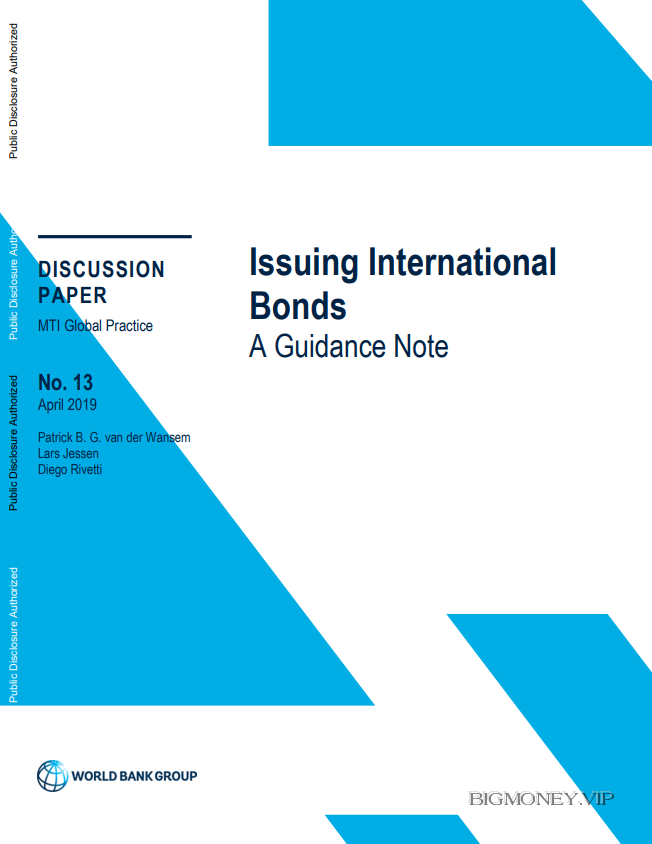Issuing International Bonds A Guidance Note by Patrick B. G. van der Wansem, Lars Jessen, Diego Rivetti

Step 1: Pre-Phase
For a Minister of Finance with imminent financing needs, international commercial financing
can be perceived as an attractive, quick opportunity to cover financing needs, despite the risks
that it could create in the debt portfolio. The alternatives may be less appealing: the domestic
capacity of developing markets is often insufficient and sufficient (semi-) concessional
financing may not be available for the intended purpose. Investment banks often have direct
access to the Minister, putting him in the driver seat, at times at the risk of sidelining debt
managers in the execution process, except for administrative support. Instead of leaning on
internal debt management capacity, an outside investment bank is often hired as direct
consultant to the Minister. Ideally, Eurobond issuance should be managed as part of standard
debt management processes and well-anchored in a medium-term debt management strategy.
Establishing a Task-Force
A high-level strategic decision process should precede the issuance of a Eurobond. First, it
should be carefully explored whether a Eurobond issuance fits the fiscal framework and does
not jeopardize debt sustainability. In addition, a major financing decision, like a Eurobond
issuance, should be taken within the framework of a medium-term debt management strategy.
The strategy provides guidance regarding financial terms, and whether an international bond
would fit in the public debt composition, relative to other sources of financing. From the
strategy comes a preferred currency, interest type, and maturity, as part of an overall financing
plan. For example, the possible maturities that would fit the redemption profile of the existing
portfolio.
One possible option would be to establish a Eurobond task-force or transaction team, composed
of different sections within the Ministry of Finance and chaired by the head of the debt
management unit.
Ideally, the debt management unit functions well and issuance of Eurobonds
are handled as a part of usual debt management decision-making and operational processes. A
task force would not be necessary in that case. The reality is that the debt managers are often
sidelined in the international bond issuance process and at times lack staffing and capacity to
manage a first transaction independently. A task force, combining several competencies, would
be a functional compromise. Meanwhile, it is essential to avoid the creation of large
bureaucratic debt committees that would slow down the process.
The task-force or debt management unit would have the following responsibilities:
1. Ensure that analyses about an international bond issuance are reflected in the medium-
term debt management strategy. The strategy, along with published borrowing plans,
will inform (international) intermediaries and investors that an issuance is being
considered and support their investment planning. Staff responsible for the medium-
term fiscal framework and budget should be involved.
2. Coordinate with the Central Bank. It is important coordinate on monetary and macro-
related aspects of the transaction, such as the impact on international reserves, on
monetary policy, the need for sterilization (and how to sterilize), etc.
3. Develop and maintain a technical understanding of international bond issuance
processes, documentation and pricing. This Discussion Paper provides initial guidance
but deepening the technical know-how, such as bond pricing, yields, credit spreads,
etc., and understanding the broader context is essential for assessing any proposals on
issuance and for subsequent negotiations. Proactive transparency and communication
could benefit the issuer affecting demand and price, as issuers are competing with each
other for a limited amount of capital available and investors do not always have detailed
knowledge about the country.
4. Collect market information from the investment banks and internally report on it.
Following the market’s risk perception and perceived correlation between issuers is
important. Banks produce a lot of research, both on the macro-economic developments
and on global and regional interest rate movements. Furthermore, there is information
on new issue activities from peer countries (currency, maturity, issue spread), as well
as secondary market pricing developments (yields, spreads). The Task Force or debt
manager could, furthermore, benefit from contacting colleagues from peer countries to
discuss their experiences with recent issuance.
5. Prepare for the selection of lead-managers. The selection process itself is elaborated
in Step 2.
6. Select a legal counsel. As illustrated in the next step, the documentation around an
international issuance is comprehensive. Ideally, the debt management unit has its own
legal expert, who should be part of the task force. However, an external legal counsel
with specialized knowledge of international securities laws and markets is still required.
7. Prepare and coordinate documentation, in cooperation with macro-fiscal and legal
departments. While documentation contains a significant amount of standard legal text,
the base prospectus requires substantial macro-fiscal disclosure, including information
on indebtedness.
8. Assign operational responsibilities. Recording the transaction, ensuring that the bond
is settled on time and arranging the ongoing debt service payments requires the
involvement of staff from the back-office and the central bank. There needs to be an
early check on aspects of accounting, payments, settlement and IT.
9. Select agents. The Task Force should be involved in selecting the Fiscal and Paying
Agent and be their ongoing contact. Usually a bank is the fiscal agent, which clears the
transactions with the clearing house. It is advised to train and test staff and system
capabilities prior to issuance. International financial market participants have no
tolerance for errors, especially delayed payments.
While each task force member will have their own responsibility, good internal information
flow and coordination are important. While not all parties need to be active from start to finish,
ongoing information exchange across the entire group is generally beneficial.
It could prove useful to discuss all the procedures prior to the issuance process with the
(external) auditor. This might be important for securing transparency and accountability, for
example with regard to the selection of lead-managers. Furthermore, it helps avoid criticism
ex-post, whether public or political.




